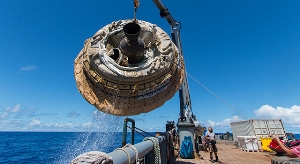Aug 6 2014
NASA's Low-Density Supersonic Decelerator (LDSD) project successfully flew a rocket-powered, saucer-shaped test vehicle into near-space in late June from the U.S. Navy's Pacific Missile Range Facility on Kauai, Hawaii. Media are invited to the agency's Jet Propulsion Laboratory (JPL) in Pasadena, California, at 9 a.m. PDT (noon EDT) Friday, August 8, to see new video from this test and hear about early results from the mission.
 Hours after the June 28, 2014, test of NASA's Low-Density Supersonic Decelerator over the U.S. Navy's Pacific Missile Range, the saucer-shaped test vehicle is lifted aboard the Kahana recovery vessel. Image credit: NASA/JPL-Caltech
Hours after the June 28, 2014, test of NASA's Low-Density Supersonic Decelerator over the U.S. Navy's Pacific Missile Range, the saucer-shaped test vehicle is lifted aboard the Kahana recovery vessel. Image credit: NASA/JPL-Caltech
The briefing will air live on NASA Television and the agency's website.
The LDSD cross-cutting demonstration mission tested breakthrough technologies that will enable large payloads to be safely landed on the surface of Mars and allow access to more of the planet's surface by enabling landings at higher altitude sites.
Participants in Friday's briefing are:
- Jeff Sheehy, senior technologist with the Space Technology Mission Directorate, NASA Headquarters, Washington
- Mark Adler, project manager, LDSD, JPL
- Ian Clark, principal investigator, LDSD, JPL
More material about the LDSD space technology demonstration mission is online at: http://go.usa.gov/N5zm
For NASA TV streaming video, schedules and downlink information, visit: http://www.nasa.gov/nasatv
The event will also be carried live on Ustream at: http://www.ustream.tv/NASAJPL2
The LDSD project is part of NASA's Space Technology Mission Directorate, which is innovating, developing, testing and flying hardware for use on future NASA missions. Over the next 18 months, the directorate will make significant new investments to address several high-priority challenges in achieving safe and affordable deep space exploration. These focused technology areas are tightly aligned with NASA's Space Technology Roadmaps, the Space Technology Investment Plan and National Research Council recommendations.
For more information about the directorate, visit: http://www.nasa.gov/spacetech